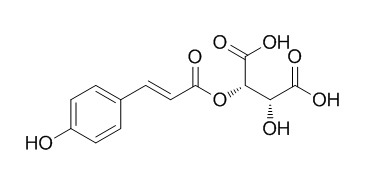trans-Coutaric acid
trans-Coutaric acid has antioxidant activity.
Inquire / Order:
manager@chemfaces.com
Technical Inquiries:
service@chemfaces.com
Tel:
+86-27-84237783
Fax:
+86-27-84254680
Address:
1 Building, No. 83, CheCheng Rd., Wuhan Economic and Technological Development Zone, Wuhan, Hubei 430056, PRC
Providing storage is as stated on the product vial and the vial is kept tightly sealed, the product can be stored for up to
24 months(2-8C).
Wherever possible, you should prepare and use solutions on the same day. However, if you need to make up stock solutions in advance, we recommend that you store the solution as aliquots in tightly sealed vials at -20C. Generally, these will be useable for up to two weeks. Before use, and prior to opening the vial we recommend that you allow your product to equilibrate to room temperature for at least 1 hour.
Need more advice on solubility, usage and handling? Please email to: service@chemfaces.com
The packaging of the product may have turned upside down during transportation, resulting in the natural compounds adhering to the neck or cap of the vial. take the vial out of its packaging and gently shake to let the compounds fall to the bottom of the vial. for liquid products, centrifuge at 200-500 RPM to gather the liquid at the bottom of the vial. try to avoid loss or contamination during handling.
Chin. Med.J.Res. Prac.2017, 31(4)
Chinese J of Tissue Engineering Res.2022, 26(17): 2636-2641.
Eur J Pharmacol.2023, 960:176121.
Nanotechnology.2024, ad470d.
Nutrients.2020, 12(11):3448.
Korean J of Pharmacognosy2020, 51,49-54.
Plant Pathology2022, 10.1111:ppa.13651.
International. J. of Food Properties 2017, 20:S131-S140
Nutrients.2019, 12(1)
Antioxidants (Basel).2021, 10(9):1487.
Related and Featured Products
Journal of Chemistry, 2016, 2016:1-8.
Antioxidant Composition of a Selection of Italian Red Wines and Their Corresponding Free-Radical Scavenging Ability.[Reference:
WebLink]
This study correlates the antioxidant composition profiles and the overall antioxidant capacities of 36 Italian red wine samples.
METHODS AND RESULTS:
The samples were fully characterized by chromatographic and spectrophotometric techniques. The overall antioxidant capacity was determined by titrating a solution of the semistable free radical DPPH (1,1-diphenyl-2-picrylhydrazyl) with each wine sample followed by Electron Paramagnetic Resonance (EPR) spectroscopy and then measuring the resulting decrease in DPPH-signal. The antioxidant activities of the samples were expressed as (+)-catechin equivalents and related to their antioxidant composition profiles. Samples with a high polyphenol content showed a high DPPH scavenging ability as well. Seven well-defined groups, mainly constituted by wines coming from the same cultivar, were evidenced by PCA analysis. Alcohol content and pH did not influence the wine DPPH scavenging ability.
The most important variables contributing to the winesa ™ antioxidant power are total flavonoid, total phenol, and proanthocyanidin indices together with fertaric acid, trans-caftaric acid, trans-Coutaric acid, and both quercetin glucoside and quercetin glucuronide.
CONCLUSIONS:
EPR is demonstrated to be faster than the other analytical methods (spectrophotometric and chromatographic analyses) to determine the wine overall antioxidant activity.
Food Chemistry, 1999, 65(1):1-8.
The polyphenol constituents of grape pomace.[Reference:
WebLink]
METHODS AND RESULTS:
Chemical investigation of Chardonnay grape pomace has resulted in the isolation of 17 polyphenols which were identified by NMR spectroscopy as gallic acid, its 3- and 4-β-glucopyranosides, trans-caftaric acid, cis- and trans-Coutaric acid, 2-hydroxy-5-(2-hydroxyethyl)phenyl-β-glucopyranoside, catechin, epicatechin, procyanidin B1, quercetin 3-glucoside, quercetin 3-glucuronide, kaempferol 3-glucoside, kaempferol 3-galactoside, eucryphin, astilbin and engeletin.
CONCLUSIONS:
Gallic acid 3-β-glucopyranoside, gallic acid 4-β-glucopyranoside and 2-hydroxy-5-(2-hydroxyethyl)phenyl-β-glucopyranoside are reported here as natural grape constituents for the first time.



